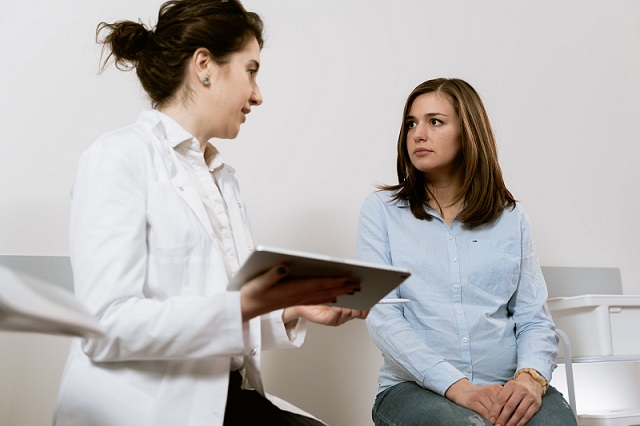6 Health Tests Every Woman Should Take
6 Health Tests Every Woman Should Take
6 Health Tests Every Woman Should Take
This blog post will cover six health tests every woman should take. These are simple and easy tests that can detect cancer and other diseases before they get too serious. We’ll provide information on how these six exams should be administered, and what the results mean to you.

Photo by MART PRODUCTION from Pexels
1. Mammogram
Once a woman turns 40, a mammogram is usually recommended. This test checks for breast changes that may suggest cancer. For these reasons, it is important for all women to have a mammogram every year. The test is done by placing a flat plastic plate over the breast. A low dose of radiation is then passed through the breast to create an X-ray image on film or digital media.
Sometimes, abnormal findings on a mammogram can appear in women who do not feel any changes in the breasts, thus increasing the chance of early detection of abnormal breast changes that may be related to cancer cells.
Different types of views occur during this test, including traditional two-dimensional (X-ray), three-dimensional stereo, point compression, tomosynthesis (also known as “breast ultrasound”), ductography where a contrast agent is injected into the milk ducts under X X-rays to see if there are blockages preventing normal outflow of the glands, mammograms are used to plan surgical procedures, and a digital full field of the entire breast is captured in one image.
2. Pap smear
A Pap smear is a test that checks for changes in the cells of the cervix. It can help detect cervical cancer early when it is easier to treat. You should have a Pap smear every three years starting at age 21. If you are over 30 and have three normal Pap smears in a row, you can wait up to five years between tests. Discuss with your doctor how often you need to have a Pap smear.
3. Bone Density Test
A bone density test can help determine whether your bones are healthy and strong. If you’re at risk for osteoporosis or other related conditions, you’re more likely to break a bone from even the slightest fall, bump into something, or other minor injury.
The most common way to check bone health is to take x-rays of key areas of the lower back called the lumbar spine (L-spine), hips, wrists/ankles, and neck. If these show signs of tissue loss due to thinning of the bones (osteopenia), your doctor may recommend more frequent screenings over time. Bone mass starts to decline around age 30 or 40, depending on gender and ethnicity, however, you can take precautions to keep your bones healthy.
4. Pelvic exam
A pelvic exam is a gynecological examination of the female reproductive system. It is used to screen for abnormalities and diseases such as ovarian cancer. A pelvic exam may also include a Pap smear to detect cervical cancer. A pelvic exam can be uncomfortable, but it is an important part of your health care.
Make sure you discuss any concerns you have with your doctor before the exam. You should also let your doctor know if you are pregnant or have any other medical conditions.
If you are overdue for a pelvic exam, make an appointment with your doctor right away. Remember, early detection is the key to ovarian cancer and other women’s health problems.
5. Blood test
Blood tests can help your doctor determine if you have anemia, where you don’t have enough red blood cells. This type of test can also check for other conditions, such as liver disease or diabetes.
There are many different types of blood tests and your doctor will be able to recommend the one that is best for you. Be sure to ask any questions you may have so that you understand why the test was taken and what the results might mean.
Be sure to tell your doctor if you are uncomfortable with a particular test. You should never feel rushed or uncomfortable during your visit.
6. Breast Self-Exam
Breast self-exams are an easy way for women to check their breasts for changes that could be cancer. To perform a breast self-exam, you need to see and feel your breasts. Looking at your breasts, stand in front of a mirror with your shoulders straight and your arms at your sides.
Look at each breast separately and check for shape, size, and symmetry (every breast should look the same). Check for fluid from the nipple, folds or depressions in the skin, or changes in skin color or texture.
To feel your breasts, press firmly against the fleshy part of your breasts with both hands (avoid touching around the nipples). Feel for a lump, thickening, or lump in each breast. It is important to perform a breast self-exam every month. If you notice anything about you, see your doctor right away. Early detection of cancer gives you the best chance of treatment success.

Photo by Lucas Vasques on Unsplash
Today, it seems that everyone is rushing to see the doctor. One of the most important tests every woman should have is a mammogram for breast cancer. This test can help detect early signs of certain types of cancer in women. Regular testing of this type has been shown to save lives because cancer can be treated earlier when it is more likely to be cured.
Keep it up Artkraft
Check more articles in our categories DIY Home & DIY Projects & Tips & Crafts .
Thanks for visiting we hope our article 6 Health Tests Every Woman Should Take
, think about share the article on Facebook, instagram and whatsapp with the hashtag ☑️ #Health #Tests #Woman ☑️!

